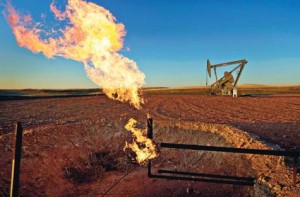 West Texas Intermediate dropped amid reports of a slowing Chinese economy and rising inventories in the US, while Brent held steady, supported by tensions in Ukraine. Meanwhile, natural gas gained momentum with weather reports forecasting cooler weather over the US and recording the highest price in two months.
West Texas Intermediate dropped amid reports of a slowing Chinese economy and rising inventories in the US, while Brent held steady, supported by tensions in Ukraine. Meanwhile, natural gas gained momentum with weather reports forecasting cooler weather over the US and recording the highest price in two months.
On the New York Mercantile Exchange WTI futures for June delivery traded at $101.59 per barrel at 12:50 GMT, losing 0.16% for the session so far. Daily high and low stood at $101.99 and $101.20 per barrel, respectively. Yesterday futures dropped 1.83%.
Meanwhile, on the ICE, Brent futures for June added 0.07 % by 12:50 GMT, trading at $109.35 per barrel. High and low for the day were registered at $109.52 and $109.06 per barrel, respectively. The European benchmark’s margin to WTI was at $7.76, widening earlier gains, to mark the biggest premium in more than 5 weeks.
Bearish estimates on US oil stocks, ahead of the upcoming Energy Information Administration weekly oil inventories report later today, pressured West Texas Intermediate. A Bloomberg survey showed that crude oil supplies probably rose by 3 million barrels, in contrast with a 519 000-barrel gain reported by the American Petroleum Institute – a private body, stoking negative sentiment.
Gasoline stockpiles are expected to have declined by 1.713 million barrels – much more than last week’s decrease of 0.154 million, though far less than APIs projection of more than 3-million-barrel fall, while distillates inventories are set to have lost 300 000 barrels, capping much of the concerns over rising crude inventories.
Supplies at Cushing, Oklahoma – the delivery point for WTI and a major factor in forecasting oil inventories, have been lowering since January, when crude stocks began a partial relocation to hubs along the Gulf. “Supply drops at Cushing have trumped the big builds nationwide in recent months, but that may be about to change,” said for Bloomberg Bob Yawger, director of the futures division at Mizuho Securities USA Inc. in New York. “There’s a realization that supplies have just moved to the Gulf Coast, where they are now at a record high.”
WTI was pressured on news that manufacturing activity in China registered a lower-than-expected PMI. According to HSBC’s preliminary report, the Chinese manufacturing PMI recorded 48.3 for April, in contrast with a 48.4 forecast. This translates to a slightly lower-than-before pace of slowdown in the world’s second oil consumer, but also boosts negative sentiment, as the reading is worse than the forecast and is still well-below the “50” contraction-expansion figure.
“China is slowing down and that’s a concern, but people don’t expect it to fall off a cliff,” said for Reuters Tony Nunan, oil risk manager at giant Mitsubishi Corp; “Going by fundamentals and without the current risk premium on oil, Brent should be closer to $100 a barrel with the U.S. benchmark around $90.”
Elsewhere, Ukraine remains an important support for Brent, as tensions there don’t seem to cool down. The failed measures of the Geneva talks last week partially countered bearish reports from China and the US, as American secretary of state John Kerry threatened further sanctions against Russia. Ukraine’s interim president Oleksandr Turchynov announced two men – including a politician from his party, were found dead with signs of brutal torture. This comes three days after fatal shooting at a militia-controlled checkpoint, which prompted Russian Foreign Minister Sergei Lavrov to blame the Ukrainian government of inciting the violence and failing to, or not wanting to, implement the Geneva measures.
Meanwhile, US vice-president Joe Biden landed in Ukraine yesterday for a 2-day visit, set to underscore American support for the government and to offer assistance in the economic and energy distribution sectors.
Natural Gas
Natural gas futures due in May grew steadily on the NYMEX today, to trade at $4.761 per million British thermal units at 12:50 GMT, adding 0.46% for the day. The session registered the highest since the extremely cold winter price for natural gas at $4.785 per mBtu. Yesterday, gains of 0.91% nullified Monday’s 0.82% loss, while on Thursday futures jumped 4.51% on US inventories data.
Chilly weather gave a significant boost to prices for natural gas. NatGasWeather.com reported that April 23rd began with cool weather over the Great Lakes and the Northeast, with forecasts depicting a colder-than-average weather through the weekend. Meanwhile, the southern US and the Plains will warm-up, though any gains in heating fuel inventories will be reversed by a following low-pressure system, which will bring a spring storm over much of the central and eastern US and will keep lower temperatures for some time to come. Elsewhere, the Pacific front will also see a period of colder-than-normal weather, as storms track in from the ocean.
According to AccuWeather.com, in New York temperatures may fall to 40 degrees Fahrenheit on April 23rd – 7 below average, while tomorrow will see a slight warm-up, with readings dropping no lower than 45, but still below the normal for this time of year. Elsewhere, Chicago is set to see pretty normal temperatures today and tomorrow, before readings begin to drop on Friday, plummeting to 10 below average, reaching as low as 37 on Saturday. On the Pacific front, Los Angeles will be experiencing normal temperatures today, with high and low at 73 and 56 degrees Fahrenheit, respectively, before enduring a cool-down during the weekend, when readings will drop to several degrees below average.
US stocks
A major shift in the market took place on Thursday, as natural gas rallied on a bullish EIA storage report which signified better-than-expected demand. The government agency reported that US natural gas inventories rose by 24 billion cubic feet in the seven days through April 11th, compared to analysts’ forecasts for a 34-bcf jump. Total gas held in US underground storage hubs amounted to 850 billion cubic feet, 50% below last year’s 1 700-bcf supplies level during the comparable week. The deficit to the five-year average storage narrowed to 54.3% from 54.7% in the previous week, retreating from an 11-year low.
Tomorrow is due the next weekly report on natural gas storage levels by the Energy Information Administration, with eyes on the replenishment figure, and, considering the US has been experiencing very active weather recently, it would take a significant change in inventories to shock markets.





